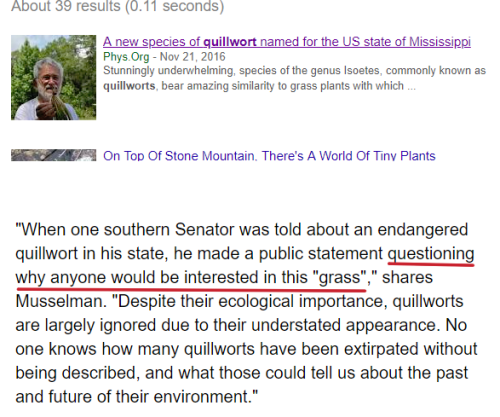aromantic-eight: botanyshitposts: dragongyrlwren: botanyshitposts: isoete: on behalf of isoetes I&rs
aromantic-eight:botanyshitposts:dragongyrlwren:botanyshitposts:isoete:on behalf of isoetes I’m offended, Mr. Senator. @botanyshitposts so what exactly is a quillwort, and what’s the big deal on this particular one? imagine if there was a single remaining mammoth species on earth, and it only was able to get by into the modern era by sacrificing it’s status as a huge landscape-changing roaming herbivore to evolve into a small animal the size of a dog. it looks a lot like a dog, actually. people often mistake the tiny mammoth species as a dog, and will just casually say it’s a dog. small-mammoth enthusiasts, however, will avidly remind people that they are not in fact a dog, and their organs, although shrunken to the size of a dog’s organs, are still wooly mammoth organs. you actually have to seek out special vets for the small wooly mammoths because even though it looks remarkably like a dog to the untrained eye, when you’re faced with the internal anatomy it’s so far deviated from anything living today that it’s difficult to understand and work with. this is because there is, quite literally, no animal anatomy quite like the small woolly mammoth’s left alive on earth. this means that there’s no living approximation of how their organs work, or what the fuck is going on in there, even though they look like a dog from the outside. the closest living relative of the small woolly mammoth is so far deviated from it’s anatomy that’s literally of no help to anyone to compare the two, because the only thing they have in common is how they reproduce. scientists studying the wooly mammoth’s anatomy are forced to debate with each other constantly about what a certain organ might do, or what it at least used to do based on the fossils of the giant wooly mammoths that once dominated the landscape, but they just…have no idea. so the small woolly mammoth is not at all like a dog, even though it looks like one. how it works, how it reproduces, how it functions on a basic anatomic level are so utterly and completely prehistoric that they’re not at all like any other living animals. this makes them the subject of infinite fascination to paleontologists trying to approximate the biology and ecology of the giant woolly mammoths that once lived…but it’s incredibly challenging. it’s also incredibly challenging to explain why they’re different to people who just don’t care, or just see them as dogs because they look like them, because the significance of something like it is so easily lost when something looks ‘normal’.isoetes –Quillworts– are that tiny wooly mammoth. their ancestors lived 400 million years ago and included the giant prehistoric spore-reproducing trees lepidodendron, which made up the bulk of massive prehistoric forests that were eventually compressed into the coal we’re still using today. they’re so old that the roots aren’t roots, they’re leaves, and it took botanists 100 years of bickering to finally confirm this. they’re so old that the change that weeded out all the giant 100+ foot tall members of the lineage was literally the original shifting of the continents, as in, like, when pangea split. they’re so old that it reproduces through ENORMOUS spores contained in spore packets on it’s leaves. they’re so old that we just have no fucking idea how to process it. quillwort anatomy is, quite literally, that of a comically small 400 million year old spore tree with the trunk squished into a woody structure so small that you could miss it if you didn’t know what you were looking for on a dissection. the anatomy of this genus doesn’t function like any other modern plant genus on earth. quillworts have organs and cell structures that we still don’t understand in the year 2019. quillworts are incredibly valuable finds to paleobotanists because they’re so easily passed over in botanical surveys, and their habitats are constantly being threatened, making a great deal of species endangered. although they’re still around on almost every continent– see the earlier point on them evolving before the continents split– there are a lot fewer of them out there now; like anything, they can be more common in some areas than others, but my state has only found one recorded colony in the past 50 years to give an idea of what we’re dealing with here. and yes. they look like grasses.do not let this prehistoric spore tree fool you[id: Screenshot of a headline that reads “A new species of quillwort named for the US state of Mississippi” published in Phys Org on Nov. 21, 2016, with an excerpt preview that reads “Stunningly underwhelming, species of the genus Isoetes, commonly known as quillworts, bear amazing similarity to grass plants with which…”Another screenshot shows a paragraph that reads” “When one southern Senator was told about an endangered quillwort in his state, he made a public statement questioning why anyone would be interested in this “grass”,” shares Musselman. “Despite their ecological importance, quillworts are largely ignored due to their understated appearance. No one knows how many quillworts have been extirpated without being described, and what those could tell us about the past and future of our environment.” This is followed by two reaction shots to that, and then at the bottom is a picture of someone holding up a quillwort, which looks like eight slightly oddly shaped blades of grass that all connect at the base. end id] -- source link
Tumblr Blog : isoete.tumblr.com

